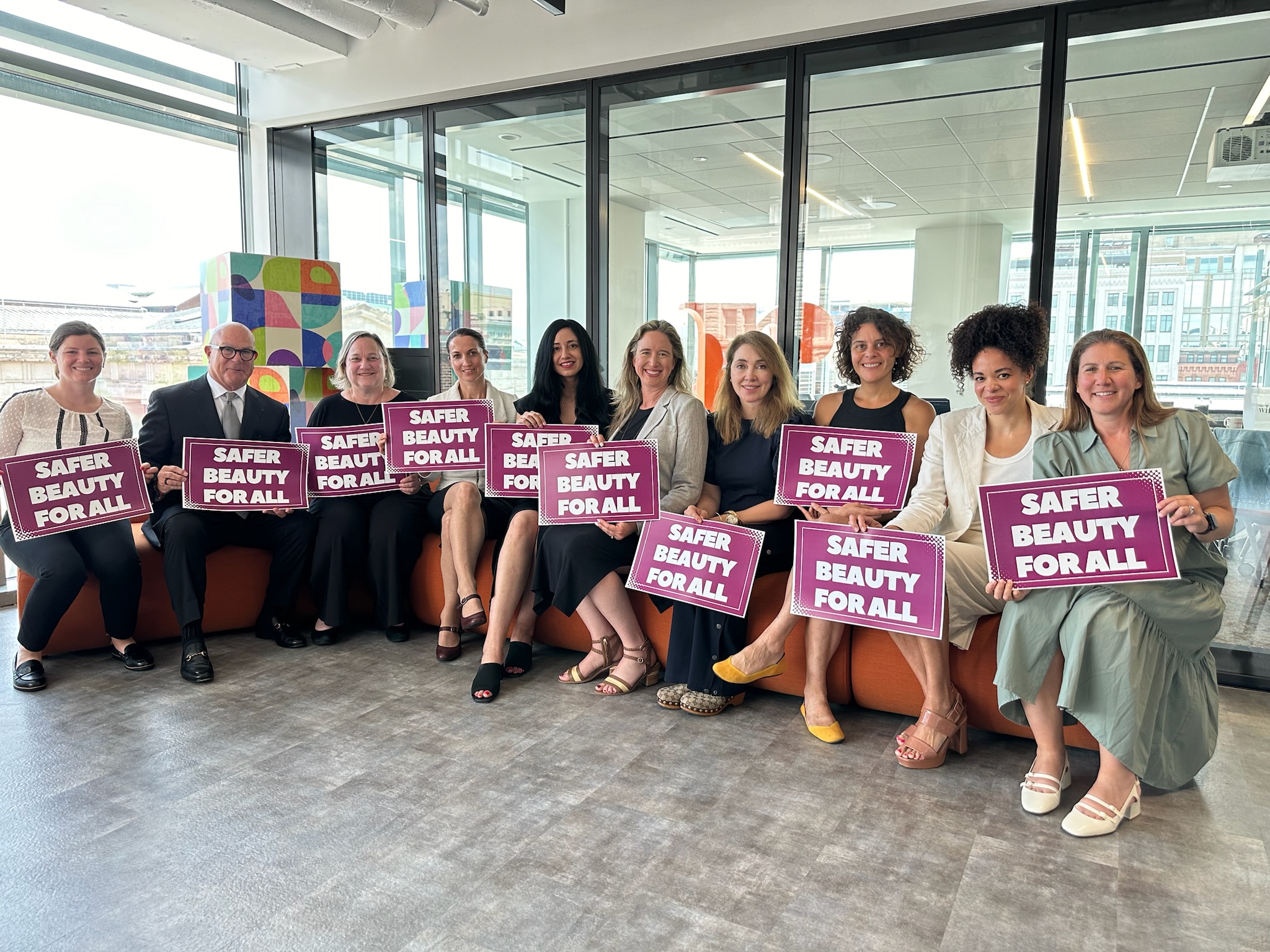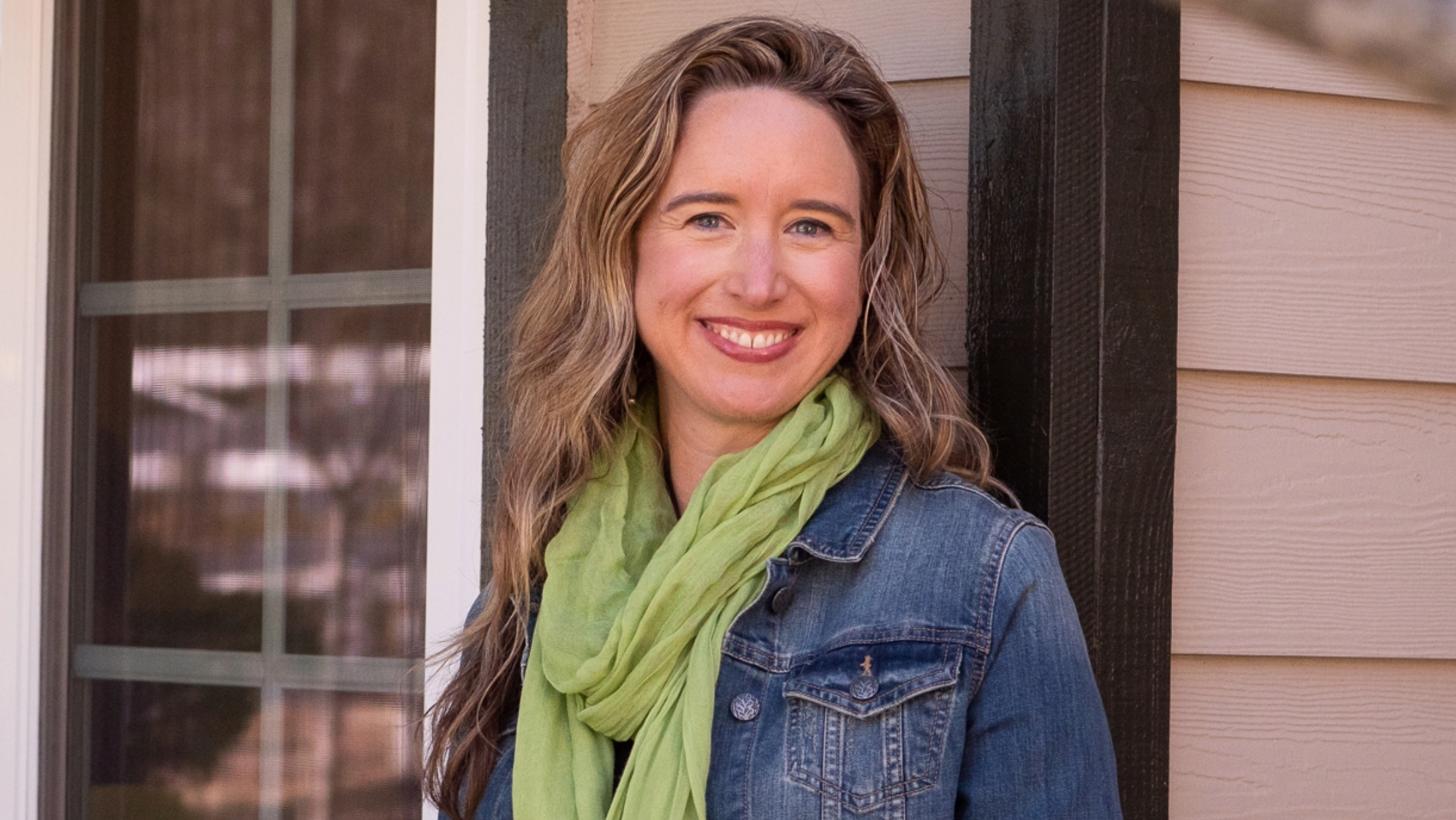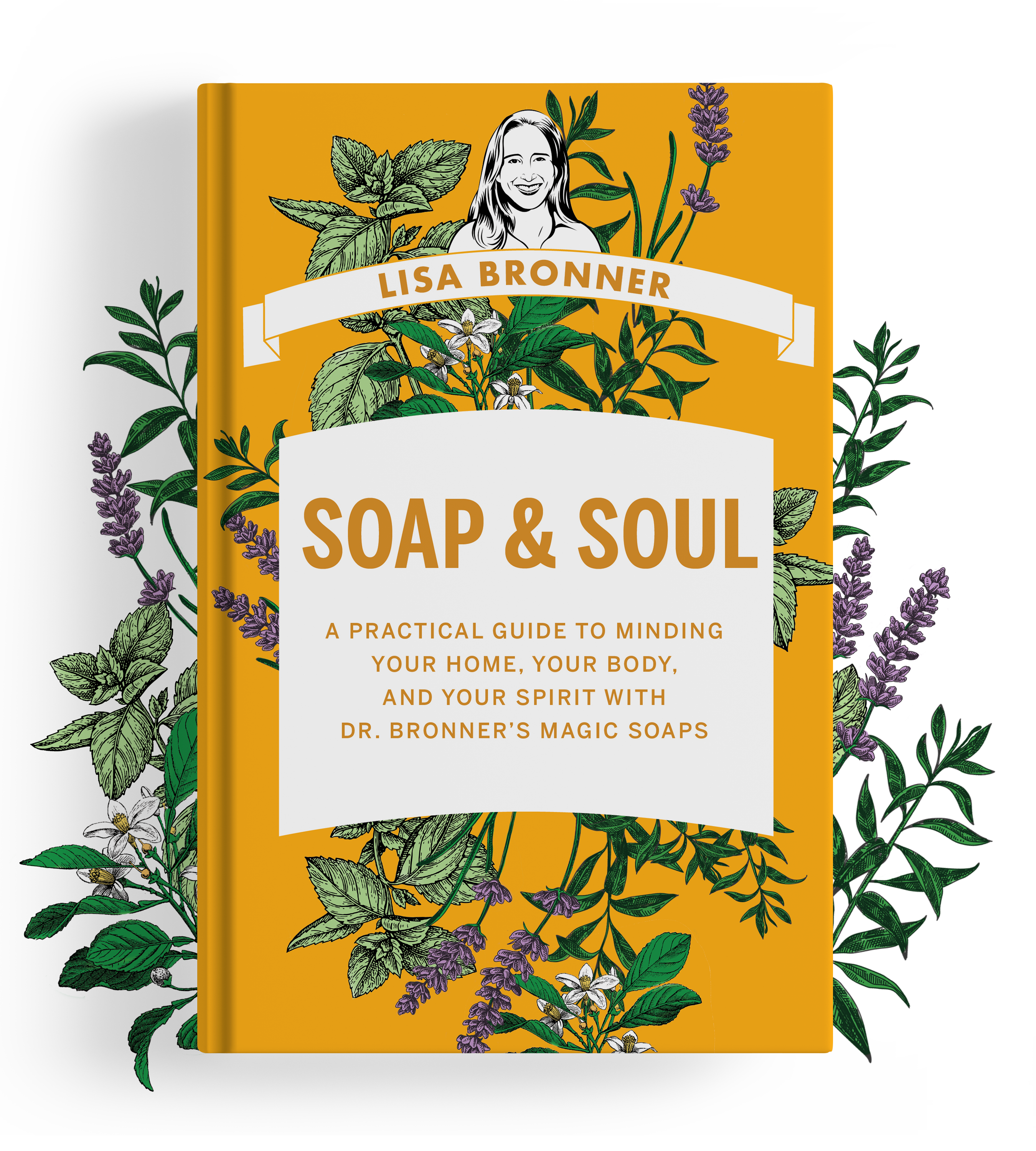
13 products a day with 169 unique ingredients. That’s the average number of products and ingredients each of us use every day. And most of us don’t give them a second thought.
They’re part of an invisible layer we wear beneath our clothes, invisible to the eye and invisible to the mind. Even if we want to know more about these products, we often can’t because current laws surrounding manufacturing and labeling block consumers from this knowledge.
Join me in calling for greater safety and transparency around our everyday products, especially to protect our most vulnerable populations (the young, the elderly, the pregnant, the infirmed, the sensitive) as well as the most targeted populations (people of color and salon workers).
Why we need to take action on cosmetics regulation
There is a misplaced trust that someone somewhere has already checked our personal care products for safety or else they wouldn’t be on store shelves. Debunking this trust makes up a lot of the work that I do.
Let’s be more efficient about improving consumer safety around cosmetics. Instead of my teaching each individual consumer how to read labels and determine what’s safe, let’s put some ground rules in place to clean up these products and make less of a quagmire for consumers to wade through.
There’s a part for you to play in this. We need your voice to add to the call for further regulation of the cosmetics industry.
In my last article, I told you all my wide-eyed impressions of spending two days advocating in Washington, D.C., but I didn’t dive deeply into why I was there. I went to D.C. to advocate on behalf of consumer safety and specifically for 5 bills that make up the Safer Beauty Package that is currently in the House of Representatives. These bills need concerned citizens to build momentum to push them through the House, and we need Senators to sponsor Senate versions of the bills as well.
A (super brief) history of U.S. cosmetics regulation
The tricky spot we’re in with cosmetic regulation is that we have just enough regulation to make it look like things are taken care of, but nowhere near enough to ensure safety for all.
Oversight began with the Federal Food, Drug, and Cosmetic Act of 1938, which contained 14 measly lines about cosmetics, and then nothing significant was added to this oversight for 84 years. 84 years. Think about all the cosmetics that have come and gone and come again from 1938 to 2022, with near silence on the safety of all those novel ingredients and compounds. To date, only 11 specific ingredients or compounds have been restricted. While there is no magic number, the European Union (EU) has banned over 1,700. I can’t say whether they’ve gone too far, but the difference between 11 and 1,700 is worth some questions.
Then came the Modernization of Cosmetics Regulation Act of 2022 (MoCRA) which sounds promising and did make some strides forward: manufacturing facilities, products, and ingredients must be registered; serious adverse health events must be reported; the U.S. Food and Drug Administration (FDA) can recall harmful products; talc must be tested for asbestos; and certain fragrance allergens must be identified on label.
However, MoCRA fell short in a number of areas, including still not restricting any further harmful ingredients from appearing in formulations and not requiring the disclosure of all flavor and fragrance ingredients to consumers.
This is why we still have work to do and why your help is needed.
In the wake of MoCRA, the Breast Cancer Prevention Partners (BCPP) doubled down on advocacy to fill in these gaps. The BCPP is a national organization that Dr. Bronner’s has long worked with, and whose purpose is to eliminate toxic chemicals and other environmental exposures that lead to breast cancer. Spurred by the leadership of Janet Nudelman, they organized the advocacy days I joined in D.C.
I also want to give a shout-out to Rep. Jan Schakowsky of Illinois, a long-time champion of cosmetic safety, who joined with others to sponsor these bills.
We all use cosmetics
“Cosmetic” does not mean “makeup.” I want to clear that up just in case you’re thinking that if you don’t wear makeup, you can ignore this topic. That 1938 Act mentioned above, that founded the FDA, defines cosmetics as “articles intended to be rubbed, poured, sprinkled, or sprayed on, introduced into, or otherwise applied to the human body…for cleansing, beautifying, promoting attractiveness, or altering the appearance.”
With that definition in mind, all of the following are cosmetics: shampoo & conditioner, shave cream & gel, lotion & balm, perfume & cologne, aftershave & toner, hair gel/mousse/spray/cream, deodorant (but not antiperspirant), most cleansers (except true soaps like Dr. Bronner’s Pure-Castile), non-fluoride toothpastes, and yes, makeup.
It gets a little fuzzy in the weeds, but I can say in summation, we all use cosmetics.
What each of the 5 Safer Beauty bills tackle
H.R. 3619: The Toxic-Free Beauty Act
As the BCPP says, “Ban the worst first.”
This bill targets 11 specific ingredients that are known to be the highest hazard. There has been a great deal of research into the safety of ingredients that has revealed where problems lie. (Here are a few studies for your bed time reading to get you started.) Whatever the reasons for the inaction in keeping these hazards out of consumer products, it has not been because we don’t know they’re harmful. Despite this knowledge, MoCRA did not include any restrictions on specific ingredients.
This law would put a federal ban on 11 of the worst. The BCPP summarized well the hazards posed by each of these, and in what products they’re found. (Words are theirs, highlighting’s mine.):
- The two phthalates– DBP and DEHP –found in nail polish and fragrance are linked to birth defects, breast cancer, and endocrine disruption.
- Formaldehyde, paraformaldehyde, and methylene glycol (3 different kinds of formaldehyde) are used in hair straightening/hair smoothing products. Quaterniun-15 (a formaldehyde-releasing preservative) can be found in body wash, makeup, and hair products, including baby shampoo. These chemicals are linked to cancer, skin irritation, and respiratory harm.
- Isobutylparaben and isopropylparaben are found in sunscreens, lotions, eyeliner, blush, and hair products. Parabens are hormonally active chemicals linked to breast cancer, reproductive harm, and endocrine disruption.
- M-Phenylenediamine and o-Phenylenediamine are chemicals used in hair dye linked to skin sensitization, cancer, mutagenicity, and organ system toxicity.
- Mercury – although banned in the U.S. except as a preservative in products around the eyes – can still be found in skin-lightening creams, beauty and antiseptic soaps, and lotions. Mercury can negatively impact the brain and nervous system.
Here’s a task for you right now: look for these in the products you own or might buy. The only ones you won’t find listed are phthalates since they often hide within the term “fragrance.”
One final point on this bill that I found interesting: California and Maryland, as well as the EU, have already banned these ingredients (and more) in products made or sold within their borders. Multinational companies who sell in both the U.S. and the EU already make and sell different formulations to comply with the different laws.
Learn more about the Toxic-Free Beauty Act.
H.R. 3620: Cosmetic Safety for Communities of Color and Professional Salon Workers Act
There are two realities that especially disturb me in this conversation about cosmetic safety. The first is that products marketed to people of color always contain far higher amounts of hazardous compounds leading to far higher exposure. I could write at great length about why I think this is, but to stay on this topic of regulation, it is undisputable that products marketed to communities of color are especially bad.
Black women who use chemical hair straighteners are 30% more likely to develop breast cancer, and black women who use hair dye are 60% more likely. The Environmental Working Group’s study of over 1,000 products marketed to people of color found that, “In the categories of hair relaxers, hair colors and bleaching products, lipsticks, and concealers, foundations and sun-protective makeup, none of the products analyzed were scored as ‘low hazard.’” I added the italics there because this is indefensible.
The second disturbing reality is that products marketed to salon workers haven’t had the same protections as products marketed to the public, despite the fact that salon workers are likely exposed to these ingredients for many of their working hours. An individual may encounter a problematic hair dye once every six weeks, but a stylist may encounter that dye eight times a day. Problems in products are going to impact the most highly exposed people the most.
Many salon workers don’t have the educational materials easily available to know of these hazards, and they also don’t have a lot of options to avoid them.
This bill will provide the following:
- Access to translated safety data sheets, a document that provides information on the hazards of a chemical and how to work with it.
- Funding for research grants to identify chemicals of concern in beauty and personal care products marketed to these already vulnerable populations,
- Funding for the development of green chemistry safer alternatives,
- Funding for two new national resource centers focused on Beauty Justice and Health and Safety Protections for Professional Salon Workers.
These are highly exposed and often undervoiced populations that are bearing the brunt of this laxity around cosmetic regulation.
Learn more about the Cosmetic Safety for Communities of Color and Salon Workers Act.
H.R. 3621: Cosmetic Fragrance and Flavor Ingredient Right to Know Act
Here’s the thing. At first glance, it may look like MoCRA already covered this one. MoCRA mandates that all ingredients be disclosed to the FDA. However, from there only ingredients from a list of common allergens must be disclosed to consumers. This is not full disclosure to consumers.
A learning I have gleaned from over 15 years in customer service is that people can be allergic to anything. I have come across corn, soy, coconut, aloe, mint allergies and more. Mandating disclosure only of common allergens will not give all people the information they need in order to decide what products are best for them.
As it stands, fragrance and flavor ingredients in cosmetics are protected as trade secrets and are not required to be listed. When you see the words “fragrance” or “flavor” in an ingredient list, know that they are not a single ingredient. They are categories. The category of “fragrance,” for example, contains any of 3,500 possible ingredients listed by the International Fragrance Association.
Without full disclosure, sensitive populations will still have to avoid products listing the category “fragrance” or “flavor” in its ingredients without disclosing what those fragrance and flavor ingredients are. This bill will require disclosure of all ingredients.
Learn more about the Cosmetic Fragrance and Flavor Ingredient Right to Know Act.
H.R. 3622: Cosmetic Supply Chain Transparency Act
It’s not just consumers who struggle to know what’s in the products they’re using. Manufacturers of cosmetics also purchase compounded ingredients from upstream suppliers. A large enough manufacturer has the weight to demand full disclosure of these ingredients or else they’ll make their significant purchases elsewhere, but a smaller manufacturer does not have this pull.
This bill will enable cosmetic companies of all sizes to be able to get the information they need to make safer products and to share this transparency with their customers.
Learn more about the Cosmetic Supply Chain Transparency Act.
H.R. 6519: No PFAS in Cosmetics Act
PFAs are the so called “forever chemicals” and are far easier to say as an acronym instead of per- and polyfluoroalkyl compounds. (Though I did learn after being wrong publicly a few times that the accepted pronunciation of the acronym is not “P-F-As”, but rather “P-fuhs.”) These got the nickname “forever chemicals” because they don’t break down. They are super durable, which means that wherever they are, they stay. When this happens inside our bodies, we call this bioaccumulation.
The Centers for Disease Control found that 97% of Americans have PFAs inside them. A burgeoning body of research has linked them to breast and testicular cancer, reproductive impairment, liver and thyroid harm, and reduced effectiveness of vaccines.
They’re used because they’re super smooth, so you’ll find them in a range of products from cookware to firefighting apparel to food packaging, as well as items more relevant to this topic such as lotions, cleansers, and any makeup that is meant to glide on (foundation, lipstick, mascara, to name a few).
MoCRA contains a provision to study the impact of PFAs, but otherwise takes no action. We already have significant research into the problems they cause and have little idea of how to get rid of them. So, while PFAs continue to be used, they’ll build up more and more in us and in our environment. It’s irresponsible to continue worsening an already bad problem. PFAs are a huge category, so restricting select or specific PFAs would be futile. They also get added to ingredient compounds and packaging all up and down the supply chain.
For these reasons, this bipartisan bill calls for an entire category ban from personal care products. Five states have already instituted a ban on PFAs intentionally added to personal care products.
Learn more about the No PFAS in Cosmetics Act.
Now it’s your turn to act in support of cosmetic safety
Now we come to the really simple part. One thing I love about the BCPP is that they make it so easy to jump into the action.
This landing page they made for the Safer Beauty Bill Package contains links towards each bill, further reading on MoCRA, as well as the all-important “Take Action” section.
On the “Take Action” page, you enter your address, and then your representative’s name will pop right up, along with their contact. How easy is that? Then, you can use the template they provide for what to say or write your own thoughts.
Once you send it, someone on the representative’s side will record that you contacted them on this topic and what stance you want your representative to take. You likely will receive a response back from their office – probably a form letter, but still an acknowledgment that you reached out and took part in our legislative process.
Once again, this is where you can take action: BCPP’s Take Action for Safer Beauty
Well done! Let me know what you do and how it goes. I’d love to hear any thoughts you have about being involved in this way.
Thinking of my daughter
I write all of this with my 15-year-old daughter in mind. Personally, I don’t use a great variety of cosmetics, and I’ve done my research and read my labels. But my daughter isn’t equipped for all of that. She hasn’t stood in the floodgate of the research. She hasn’t learned to recognize all the multisyllabic perils hiding in the ingredient lists. Nonetheless, she is in one of the most targeted demographics in our culture when it comes to cosmetics.
When I read about hormone disruption and neurological impact and bioaccumulation and carcinogens in everyday products, I think of her developing systems and wonder what will be the long-term impact.
Yes, I am present and able to guide her through these products. But what about all those millions of 15-year-olds out there who don’t have an ingredient wonk for a mom? What are they being exposed to and at what point will they see the effects? Why do we have to wait until we see the dire results when we already have the red flags to show us where they’ll be?
Please join me in putting these safety measures in place. For yourself, for our kids, for our vulnerable and undervoiced populations. It is the beauty of our representative democracy that we can each use our voice to effect change.
Reach out to your representatives today to let them know you care, and they should too.
Further reading:



Please allow known safe products only.
The work you’re doing in educating Mom’s and young girls, boys, all of us, is so important. It’s for us to do the work of informing ourselves as to product safety for the sake of our planet and people. Thank you for guiding us on this road.
Thank you Lisa! I got into teaching because I think that is best way to improve the world. I appreciate your work educating us on these chemicals.